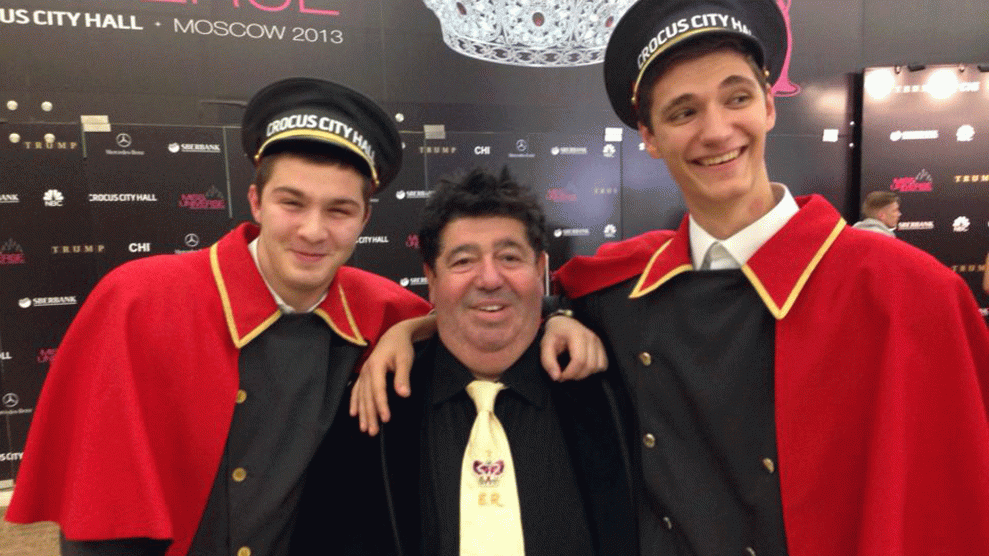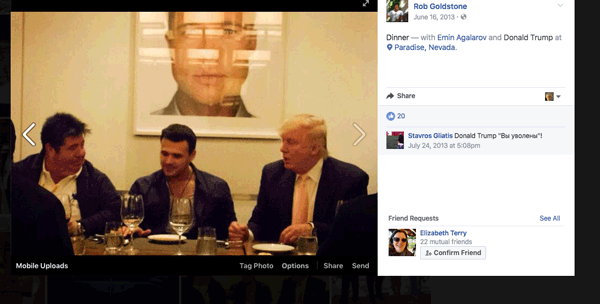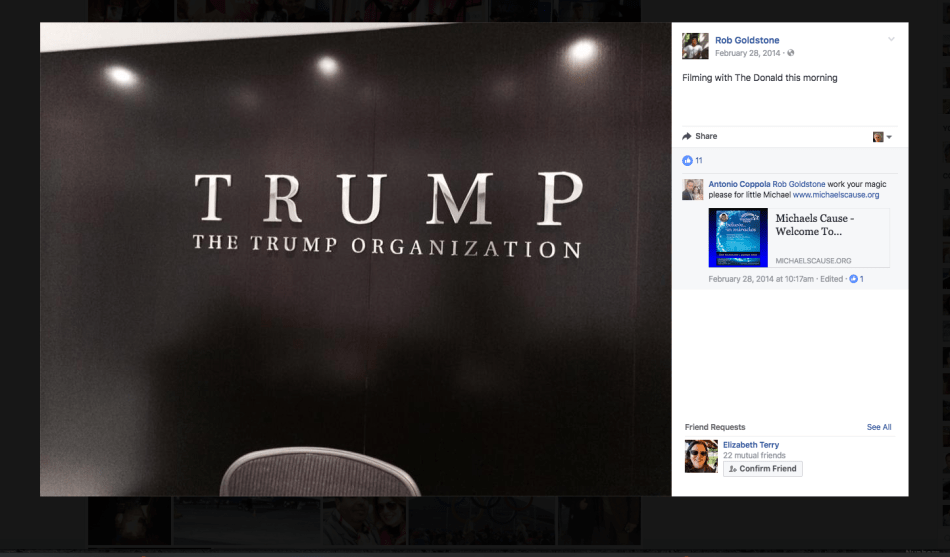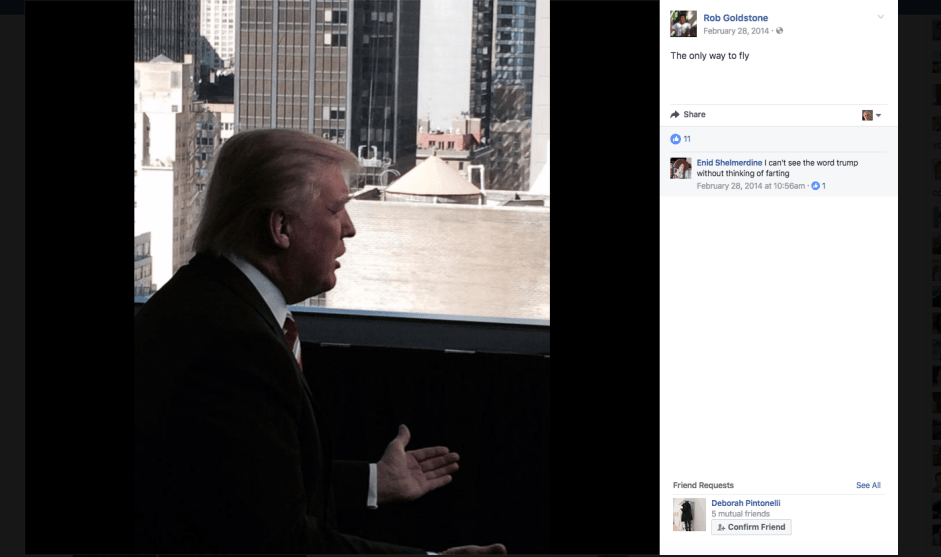
Rob Goldstone, center, attends the Miss Universe contest in Moscow in 2013.Rob Goldstone/Facebook
After the Trump camp for months has denied any connections between Donald Trump’s inner circle and Russians during the presidential campaign, the New York Times reported this weekend that in June 2016, Donald Trump Jr., Paul Manafort, then Trump’s top campaign official, and Jared Kushner, Trump’s son-in-law, met in Trump Tower with a Kremlin-tied Russian attorney who was peddling dirt on Hillary Clinton. As Trump critics pointed to this as evidence of possible collusion between Trump and Russia, the younger Trump claimed the meeting was mainly about Russian adoption policy and was set up by “an acquaintance” of his, but he didn’t identify the person. An entertainment publicist and manager named Rob Goldstone, though, told the Washington Post on Sunday that he had arranged the meeting at the request of a client and had attended it along with the Russian lawyer, Natalia Veselnitskaya. But Goldstone would not name his client. The Post noted that Goldstone is friendly with Trump Jr. and was “active with the Miss Universe pageant and works as a manager for Emin Agalarov, a Russian pop star whose father is a wealthy Moscow developer who sponsored the pageant in the Russian capital in 2013.”
Goldstone’s role in the Trump universe is far more important: he brokered the deal that led to Donald Trump’s most successful business venture in Russia. And on Monday, Goldstone revealed that his client in this matter was Emin, who goes by only his first name.
Emin is the son of Aras Agalarov, a billionaire and Putin-friendly developer in Russia, who owns Crocus City Hall, a mall and exhibition center outside Moscow featuring a ritzy theater. This means that this episode is now linked to an oligarch tied to the Russian regime.
For decades, beginning in 1987, Trump tried to develop projects, mainly hotel and condo complexes, in Russia. But all his plans flopped, except for one: Miss Universe. In 2013, Trump, who then owned the pageant, held the contest in Moscow. He used the event to conduct talks with oligarchs and Russian businessmen about launching a Trump hotel in Moscow. He repeatedly suggested publicly that mounting the pageant there would put him in good standing with Russian leader Vladimir Putin. And the beauty contest, which was broadcasted around the world, earned the Miss Universe Organization about $10 million in foreign income that year.
Goldstone helped make all that happen for Trump.
A British journalist-turned-publicist who now lives in New York City, Goldstone has for years managed Emin’s music career. The Azerbaijani pop singer of moderate fame often chronicles his jet-set lifestyle by posting shots from night clubs, beaches, and other hot spots on Instagram.
A few years back, Goldstone was looking for ways to boost Emin’s struggling career. Emin, who had grown up in New Jersey, wanted to be a hit in the United States—and that wasn’t happening. In 2013, Emin produced a music video for one of his Euro-pop songs, and it featured Olivia Culpo, who had won the Miss Universe contest in 2012. This led to a meeting between Paula Shugart, the head of the Miss Universe Organization, and Goldstone, according to a source with firsthand knowledge of this.
Goldstone’s big idea was to book Emin on the next Miss Universe contest. The show had developed a reputation for launching new artists. (Trump has bragged, with his usual hyperbole, that Lady Gaga’s appearance at the 2008 telecast was her big break.) But Goldstone had an even grander notion: the Miss Universe show should be staged in Azerbaijan. Emin, at the time, was married to the daughter of Azerbaijan’s president. (The couple announced their divorce on Instagram in 2015.)
Holding the show in Azerbaijan was out of the question. But the conversations continued between Goldstone and Shugart, and in one discussion Emin raised the idea of bringing the event to Moscow. Shugart was dubious. There was no appropriate venue there, she pointed out. Emin mentioned Crocus City Hall and, according to the source, said, “I own it.”
A deal was negotiated between the Agalarovs and the Miss Universe Organization, with Goldstone a part of the talks. When Trump was informed an agreement had been reached, he was “enthusiastic and happy,” according to the source. The Agalarovs would cover a chunk of the $20 million budget. Emin would be featured during the show. The final contract was signed in Las Vegas in June 2013, at the time of the Miss USA contest, which Trump also owned. At a celebratory dinner in Vegas, Goldstone sat next to Emin, who was seated next to Trump. Goldstone posted a photo of the dinner on his Facebook page:

On the stage at the Miss USA event that night, with Emin and Aras Agalarov standing nearby, Trump announced he would stage that year’s Miss Universe contest in November in Moscow. The next day, Trump tweeted:
Do you think Putin will be going to The Miss Universe Pageant in November in Moscow – if so, will he become my new best friend?
— Donald J. Trump (@realDonaldTrump) June 19, 2013
The Miss Universe show, which Trump has hailed as a great success, forged a bond between the Agalarovs and Trump. After the event, Trump announced he would work with Aras Agalarov to develop a Trump tower in Moscow. Weeks later, Trump appeared in an Emin music video that was shot the day of the Miss Universe show. And in February 2014, Goldstone posted a series of photographs on Facebook noting he was involved in another video shoot with Trump.


At the end of 2014, Trump shot a video celebrating Emin’s 35th birthday. “You’re a winner,” he told him. “You’re a champ. You’re great at real estate. And, boy, can you entertain.”
The Moscow hotel project never happened. But in March, Emin told Forbes that he and his father have maintained an ongoing relationship with Trump and his family, noting he had recently exchanged messages with Donald Trump Jr. “We thought that building a Trump Tower next to an Agalarov tower—having the two big names—could be a really cool project to execute,” Emin said. He added, Trump “ran for president, so we dropped the idea. But if he hadn’t run we would probably be in the construction phase today.”
Trump’s relationship with the Agalarovs had led to the successful Miss Universe show and has been a key component of Trump’s association with Russia. Goldstone was responsible for that relationship.
In a statement, Trump Jr. downplayed the meeting and the discussion of opposition material regarding Clinton: “After pleasantries were exchanged, the woman stated that she had information that individuals connected to Russia were funding the Democratic National Committee and supporting Clinton.” He claimed Veselnitskaya’s “statements were vague, ambiguous and made no sense. No details or supporting information was provided or even offered. It quickly became clear that she had no meaningful information.” Then, Trump Jr. maintained, the conversation shifted to the Magnitsky Act, a 2012 law imposing sanctions on certain Russian officials and the negative impact the measure had on Americans seeking adoptions in Russian. Veselnitskaya has long been involved in efforts opposing the Magnitsky Act.
Given Goldstone’s ties to the Agalarovs and Trump—and the friendship between Trump and Emin—it is not so odd that this talent manager had influence with Donald Trump Jr. and could set up this curious session with Trump’s most intimate advisers. The bigger mystery now is the precise role the pop-star son of a Russian oligarch associated with Putin played in trying to pass derogatory Clinton information to the Trump campaign—and whether this effort extended beyond this one meeting.
UPDATE: On Monday afternoon, Goldstone issued this statement: “I was asked by my client in Moscow—Emin Agalarov—to help facilitate a meeting between a Russian attorney (Natalia Veselnitzkaya) and Donald Trump Jr. The lawyer had apparently stated she had some information regarding illegal campaign contributions to the DNC which she believed Mr. Trump Jr. might find important. I reached out to Donald Trump Jr. and he agreed to squeeze us into a very tight meeting schedule. At the meeting, the Russian attorney presented a few very general remarks regarding campaign funding and then quickly turned the topic to that of the Magnitzky Act and the banned US adoption of Russian children—at which point the meeting was halted by Don Jr. and we left. Nothing came of that meeting and there was no follow up between the parties.”
















